WHAT TO LOOK FOR WHEN CHOOSING A BRACE
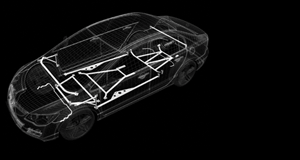
Among the many great things about South Africa is that we all have choices when it come to buying products and there should be room for all the merchants who wish to play in the game, all price and quality levels to fill the needs of various incomes and high end quality products that offer much better quality and performance. The market tells us the real economy models do little if anything to improve the rigidity of the chassis but as long as the buyer understands this before the purchase, it is perfectly alright, he's buying criteria is more "price over function." Unfortunately, too often these purchases are made with the customer expecting good results which he may not receive. Naturally, we claim that Ultra Racing bars are "better" than the products of our competitors. We have yet to meet a manufacturer of products who claims his products are inferior to the others but we do have some solid reasons for making our claim as well as testimonials from thousands of users globally who will attest to the quality and integrity of Ultra Racing products.
In this case, we need to ask ourselves what "better" means and that takes us to the question of why we purchase chassis strengthening equipment in the first place, what is it's function and what is it supposed to do? The function of Ultra Racing Chassis Bars is to reinforce and add rigidity to the chassis. There are many benefits to increased chassis rigidity and that is why manufacturers strive for rigidity, as far as production costs will allow, at the point of manufacturing. Rigidity imparts a "solid feeling" to the chassis that is perceived by the driver as "well made" and "high quality." Installation of a suitable Ultra Racing Bars when a vehicle is new, helps to maintain the original structural integrity of the vehicle over time. This translates to "still feels new" when the kilometers rack up. Automotive engineers agree that increasing chassis rigidity imparts quicker and more responsive steering as a result of reduced chassis flex. Almost every racing car has chassis braces added or built in as original equipment for the benefits this rigidity imparts. Adding a strut brace to your family SUV or sedan will not make it into a race car but most drivers can perceive and appreciate the added rigidity assuming that a good quality strut brace is selected for installation, but it will not necessarily make your car faster.
The only valid and scientific method of measuring the effectiveness of a strut brace is to measure chassis rigidity before and after installation of a given brand of strut brace. The equipment that accomplishes this costs millions of Rands and the car manufacturers are the only ones who are able to afford this equipment. Testing of chassis rigidity and methods to improve it are routine exercises at their R&D sites. Chassis rigidity is measured in units of Hertz in the USA and Newton Meters in Europe, these are highly scientific calculations.
So, this begs the question, if you need expensive equipment to measure chassis rigidity, how can we claim that ultra racing products are superior? From a purely scientific standpoint, we don't make such a claim. However, some of it is simply common sense as so many things in this world are, and some of it are basic engineering principles. For example, if the strut brace is not rigid itself, as in "pivoting joints / Adjustable Bars ", how can it add to the rigidity of the chassis ? A strut brace is subjected to various stresses placed upon it and since its purpose is to reinforce structural members of the vehicle it is added to. Weight , Diameter , material selection, design and quality of execution all come into play. In addition, for strictly cosmetic purposes, it is an added benefit if it is well finished and attractive although this has no bearing on function.
Have you ever seen an industrial crane made of wood? Of course not, and we don't have to be engineers to figure that out. The same common sense applies to many products including chassis strengthening equipment. The materials, design and build quality must combine to resist the forces applied against it, just like the industrial crane. The majority of strut braces we are aware of, even many leading brands, have major flaws of one kind or another that fail to fill the basic characteristics of a product that is designed to reinforce a vehicle chassis.
Here is a list of items not recommended for an effective strut brace: Any component that is not absolutely rigid, detracts in some measure from the intended function of the strut brace. Some brands of strut braces include almost every one of these undesirable features. Some high end brands contain two or more of these flaws.
1) Thin shock tower plates of soft, stamped materials (allows flex and movement)
2) Thin tubes that make up the cross bar (lacks the strength required to do the job)
3) Multiple bends and angles of the cross bar (each bend or angle imparts a weakness and point of flex to the brace)
4) Pivot points where the cross bar attaches to the shock tower rings. (this is outdated technology and negates any improvement the strut brace may otherwise have) As the chassis twists and flexes from side to side, the pivot points simply allow the strut brace to "float" with the movement rather than stop it.
5) Small diameter hardware, a structure is only as strong as its weakest component. You could have a cross bar of solid 2 inch thick steel but if it attaches to the rings with a 5mm bolt, its only as strong as the 5mm bolt.
6) Lack of reasonable width and diameter (assuming reasonably priced materials, not "super alloys)
7) Both cosmetic and functional, some strut braces look like they were manufactured from recycled material and provide little if any rigidity. We refer to these as "feel good" accessories. They do nothing, but the owner feels good about his new accessory. These are usually the budget products.
Any improvement in actual rigidity realized from these budget models is a result of the owners imagination and expectation.
8) And finally, appearance, if that is important to any individual buyer and we find in most cases it is. Without exception, the Budget Models all appear cheaply made because they are. The moderately priced brands appear more substantial to the casual observer and in some cases they are better. The quality brands are obvious showpieces of quality, function, design and execution.
Remember, if the product contains a lot of items on the "not recommended" list it will probably fail in its basic purpose, or perform only marginally, the customer may have purchased nothing more than a "feel good" ornament. At Ultra Racing we could easily reduce our strict quality control measures to meet the budget range of pricing, but our fundamental mission at Ultra Racing is to provide the best Quality and performance.
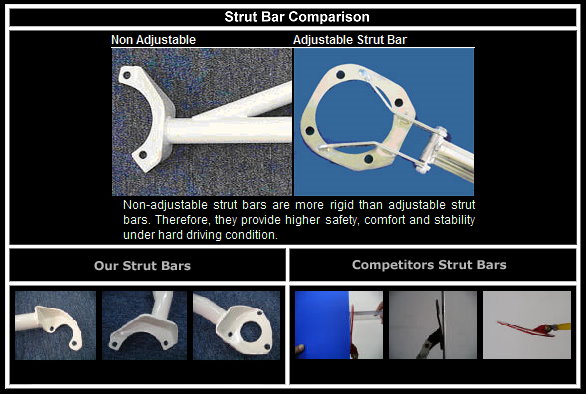
Why we use Steel instead of Aluminium?
Firstly,
steel is stronger than aluminum for the same size and thickness. In
order for aluminum alloys to be at least the same strength as steel, it
has to be at least double the thickness (steel 4mm = aluminum 8mm). When
that happens, weight saving is not so apparent anymore. Of course there
are also exotic materials and alloys that can match the strengths of
steel, but the cost are astronomically high and therefore not very cost
effective to bring into mass production All materials used are carefully selected to ensure the best performance and safety. The brackets are made of
4mm to 5mm steel plates, while the hollow steel tubes and oval tubes
are of 1.2mm to 1.6mm thickness. These materials are selected to ensure
the bars are rigid and strong to maintain constant geometry at all
times, yet safe enough to crumble during an impact.
At Ultra Racing your safety is our primary responsibility.
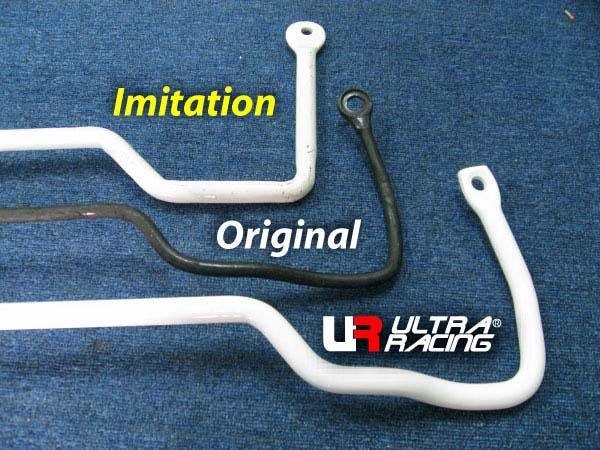
Testing is carried out using the same item on the same jig with exactly the same settings for both
Bracket : Non Adjustable
Bracket thickness : 4mm
Weight : 1.5 KG
Compression Impact : 3mm (100 psi)
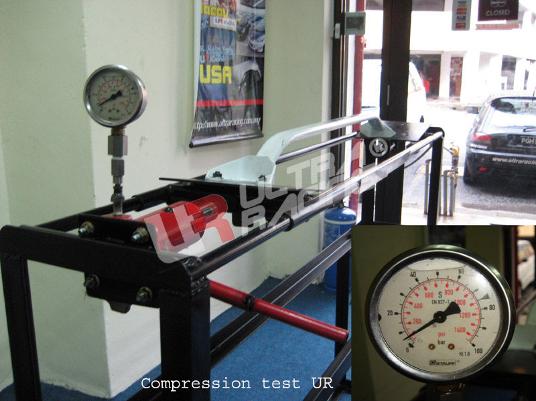
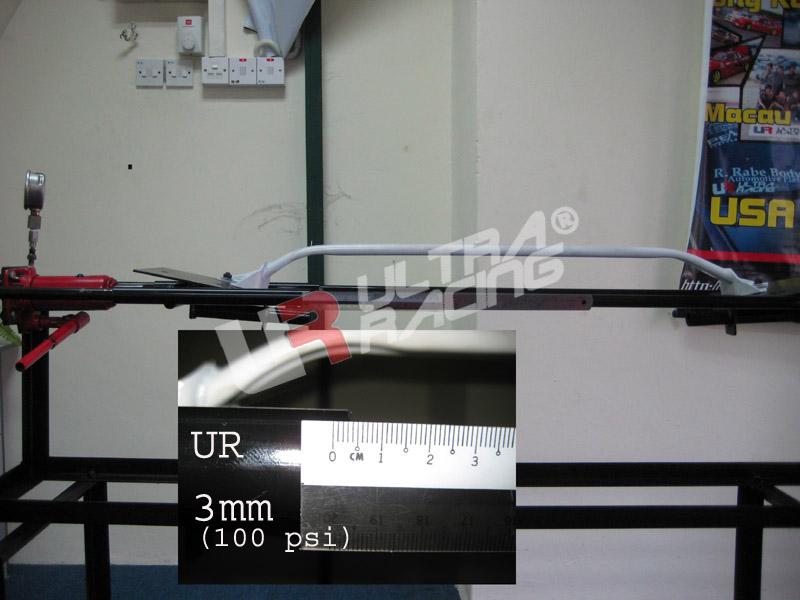
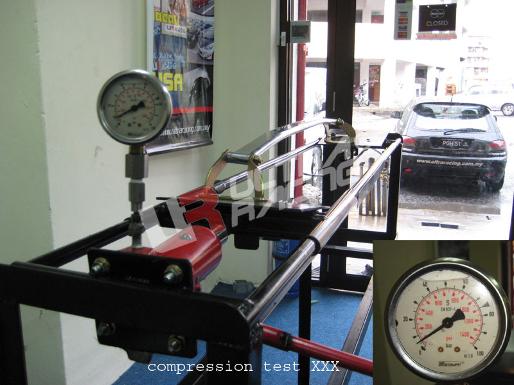
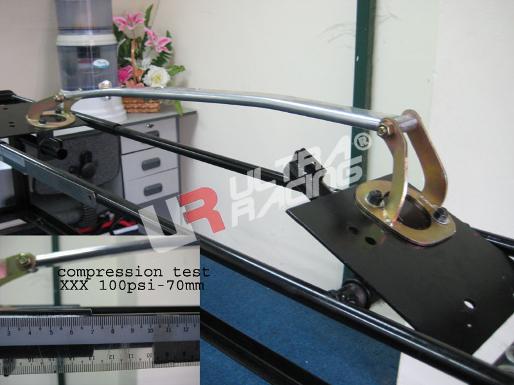
Bracket : Non Adjustable
Bracket thickness : 4mm
Weight : 1.5 KG
Flex : 50mm (8 kg/mm)
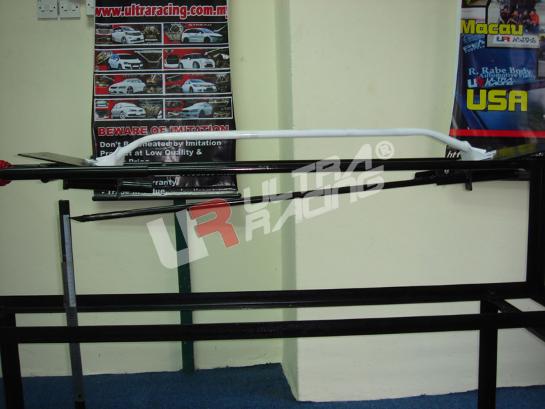
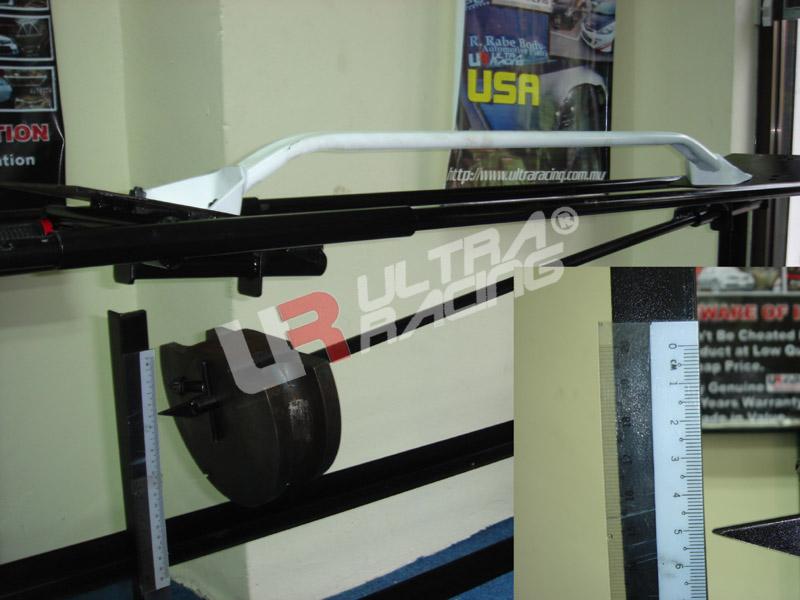
Brand : XXX (Civic EK 2 points)
Bracket : Adjustable
Bracket thickness : 4mm
Weight : 1.4 KG
Flex : ? (8 kg/m) (No reading as the competitor brand flexed and distorted beyond usable specs)
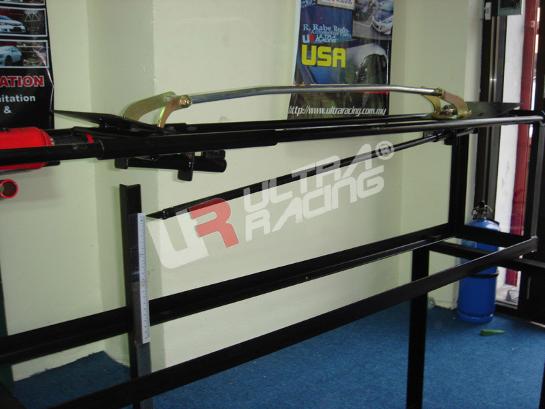
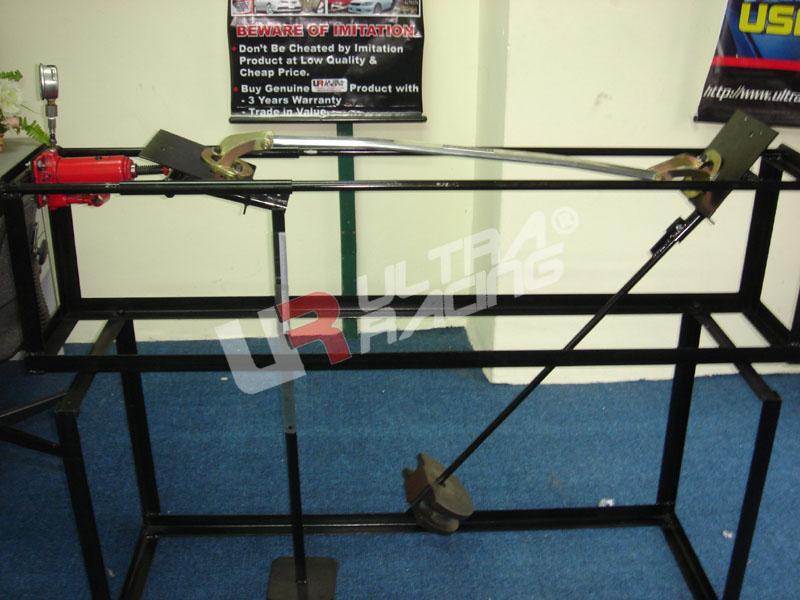
Testing is carried out using the same item on the same jig with exactly the same settings for both
Bracket : Non Adjustable
Bracket thickness : 4mm
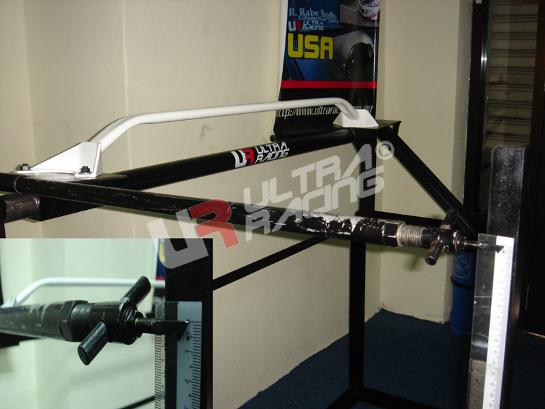
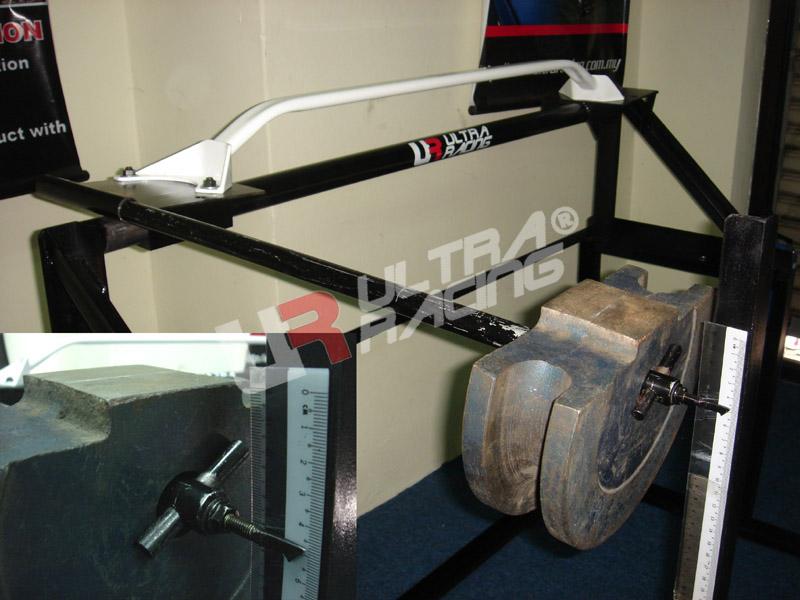
Bracket : Adjustable
Bracket thickness : 4mm
Weight : 2.0 KG
Torsion : 85mm
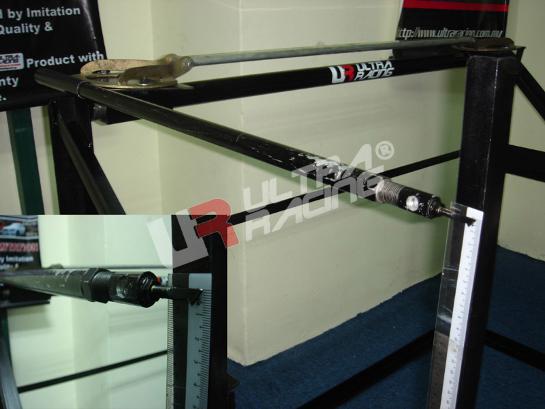
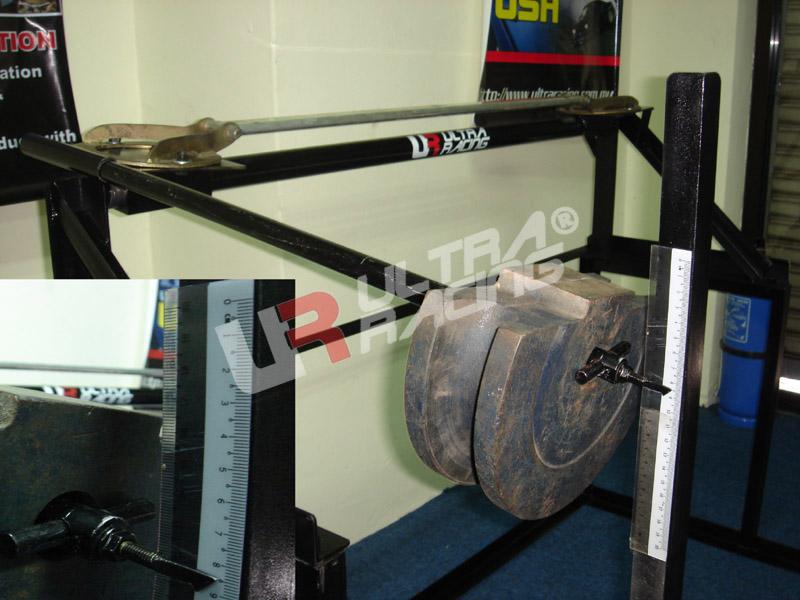
Bracket : Adjustable
Bracket thickness : 3mm
Weight : 1.4 KG
Torsion : 210mm
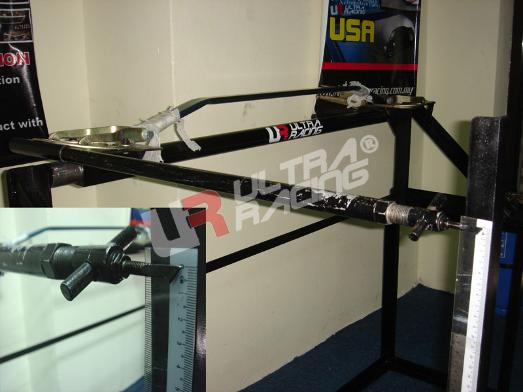
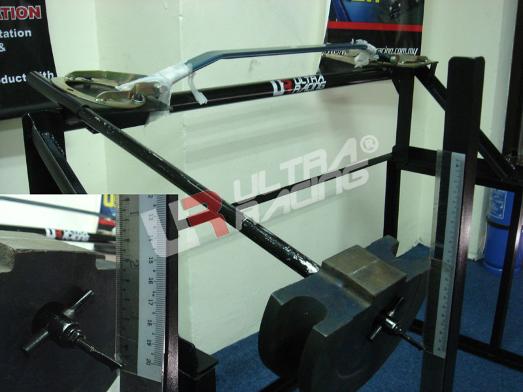
JIS 3101 SS 400 (Japan International Standard)
JIS G 3141 SPCC SD (Japan International Standard)
ASTM A 500 Grade A (American Standard)

© Copyright Ultra Racing SA
